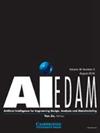在二维界面上评估虚拟对象翻译的控制感
IF 2.3
3区 工程技术
Q3 COMPUTER SCIENCE, ARTIFICIAL INTELLIGENCE
Ai Edam-Artificial Intelligence for Engineering Design Analysis and Manufacturing
Pub Date : 2023-03-02
DOI:10.1017/S0890060423000033
引用次数: 5
摘要
摘要计算机辅助设计(CAD)在设计过程中对二维屏幕创意的产生起着至关重要的作用。在大多数CAD场景中,虚拟对象转换是一项必不可少的操作,通常在设计师模拟其创新解决方案时使用。虚拟对象翻译模式的自由度直接影响用户在模拟环境中的任务表现和心理方面。在现有的文献中,对代理感(SoA)知之甚少,这是一个关键的心理方面,强调在设计过程中在2D屏幕上的翻译模式中的控制感。因此,本研究旨在通过主观和客观测量,如自我报告、任务表现和脑电图(EEG)数据,评估用户在基于鼠标、基于触摸和手持增强现实(AR)界面的虚拟对象翻译模式下的SoA。根据我们在本研究中的发现,在设计过程中,用户在1DoF翻译模式下比在3DoF翻译方式下感受到更大的控制感,这可能有助于他们想出更多的创造性想法;此外,与基于鼠标和触摸的界面相比,手持AR界面提供的控制感较小,这可能会对设计质量和创造力产生负面影响。本研究通过分析虚拟对象翻译模式与SoA之间的关联,以及CAD中不同二维界面与SoA的关系,为当前文献做出了贡献。由于这些发现,我们提出了在2D屏幕上进行虚拟对象翻译的几个设计考虑因素,这可能使设计师能够在设计过程中感受到理想的控制感。本文章由计算机程序翻译,如有差异,请以英文原文为准。
Evaluating the feeling of control in virtual object translation on 2D interfaces
Abstract Computer-aided design (CAD) plays an essential role in creative idea generation on 2D screens during the design process. In most CAD scenarios, virtual object translation is an essential operation, and it is commonly used when designers simulate their innovative solutions. The degrees of freedom (DoF) of virtual object translation modes have been found to directly impact users’ task performance and psychological aspects in simulated environments. Little is known in the existing literature about the sense of agency (SoA), which is a critical psychological aspect emphasizing the feeling of control, in translation modes on 2D screens during the design process. Hence, this study aims to assess users’ SoA in virtual object translation modes on mouse-based, touch-based, and handheld augmented reality (AR) interfaces through subjective and objective measures, such as self-report, task performance, and electroencephalogram (EEG) data. Based on our findings in this study, users perceived a greater feeling of control in 1DoF translation mode, which may help them come up with more creative ideas, than in 3DoF translation mode in the design process; additionally, the handheld AR interface offers less control feel, which may have a negative impact on design quality and creativity, as compared with mouse- and touch-based interfaces. This research contributes to the current literature by analyzing the association between virtual object translation modes and SoA, as well as the relationship between different 2D interfaces and SoA in CAD. As a result of these findings, we propose several design considerations for virtual object translation on 2D screens, which may enable designers to perceive a desirable feeling of control during the design process.
求助全文
通过发布文献求助,成功后即可免费获取论文全文。
去求助
来源期刊
CiteScore
4.40
自引率
14.30%
发文量
27
审稿时长
>12 weeks
期刊介绍:
The journal publishes original articles about significant AI theory and applications based on the most up-to-date research in all branches and phases of engineering. Suitable topics include: analysis and evaluation; selection; configuration and design; manufacturing and assembly; and concurrent engineering. Specifically, the journal is interested in the use of AI in planning, design, analysis, simulation, qualitative reasoning, spatial reasoning and graphics, manufacturing, assembly, process planning, scheduling, numerical analysis, optimization, distributed systems, multi-agent applications, cooperation, cognitive modeling, learning and creativity. AI EDAM is also interested in original, major applications of state-of-the-art knowledge-based techniques to important engineering problems.

 求助内容:
求助内容: 应助结果提醒方式:
应助结果提醒方式:


